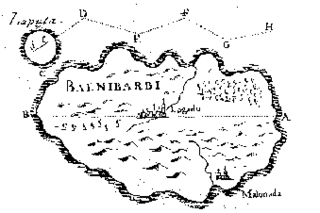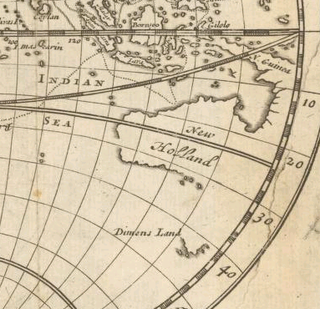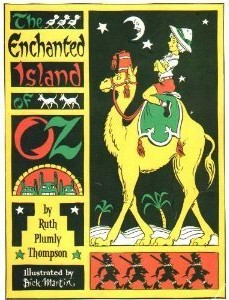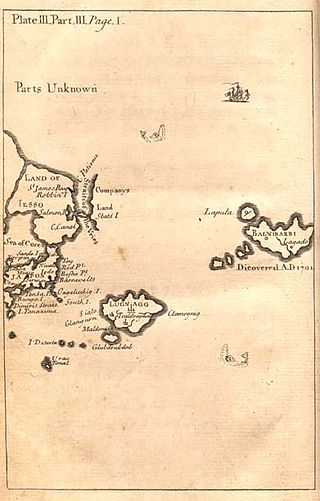
Jonathan Swift was an Anglo-Irish satirist, author, essayist, political pamphleteer, poet, and Anglican cleric who became Dean of St Patrick's Cathedral, Dublin, hence his common sobriquet, "Dean Swift".

Gulliver's Travels, or Travels into Several Remote Nations of the World. In Four Parts. By Lemuel Gulliver, First a Surgeon, and then a Captain of Several Ships is a 1726 prose satire by the Anglo-Irish writer and clergyman Jonathan Swift, satirising both human nature and the "travellers' tales" literary subgenre. It is Swift's best-known full-length work and a classic of English literature. Swift claimed that he wrote Gulliver's Travels "to vex the world rather than divert it".

Laputa is a flying island described in the 1726 book Gulliver's Travels by Jonathan Swift. It is about 4+1⁄2 miles in diameter, with an adamantine base, which its inhabitants can manoeuvre in any direction using magnetic levitation. The island is the home of the king of Balnibarbi and his court, and is used by the king to enforce his rule over the lands below.
Adamant in classical mythology is an archaic form of diamond. In fact, the English word diamond is ultimately derived from adamas, via Late Latin diamas and Old French diamant. In ancient Greek ἀδάμας, genitive ἀδάμαντος, literally 'unconquerable, untameable'. In those days, the qualities of hard metal were attributed to it, and adamant became as a result an independent concept.

Lilliput and Blefuscu are two fictional island nations that appear in the first part of the 1726 novel Gulliver's Travels by Jonathan Swift. The two islands are neighbours in the South Indian Ocean, separated by a channel 800 yards (730 m) wide. Both are inhabited by tiny people who are about one-twelfth the height of ordinary human beings. Both are empires, i.e. realms ruled by an emperor. The capital of Lilliput is Mildendo. In some pictures, the islands are arranged like an egg, as a reference to their egg-dominated histories and cultures.

Brobdingnag is a fictional land, which is occupied by giants, in Jonathan Swift's 1726 satirical novel Gulliver's Travels. The story's main character, Lemuel Gulliver, visits the land after the ship on which he is travelling is blown off course. As a result, he becomes separated from a party exploring the unknown land. In the second preface to the book, in 1727, Gulliver laments that the publisher misspelled the land's name, which Gulliver asserts is actually called Brobdingrag.

Lemuel Gulliver is the fictional protagonist and narrator of Gulliver's Travels, a novel written by Jonathan Swift, first published in 1726.

Drapier's Letters is the collective name for a series of seven pamphlets written between 1724 and 1725 by the Dean of St Patrick's Cathedral in Dublin, Jonathan Swift, to arouse public opinion in Ireland against the imposition of a privately minted copper coinage that Swift believed to be of inferior quality. William Wood was granted letters patent to mint the coin, and Swift saw the licensing of the patent as corrupt. In response, Swift represented Ireland as constitutionally and financially independent of Britain in the Drapier's Letters. Since the subject was politically sensitive, Swift wrote under the pseudonym M. B., Drapier, to hide from retaliation.

Gulliver's Travels is an American-British TV miniseries based on Jonathan Swift's 1726 satirical novel of the same name, produced by Jim Henson Productions and Hallmark Entertainment. This miniseries is notable for being one of the very few adaptations of Swift's novel to feature all four voyages. The miniseries aired in the United Kingdom on Channel 4, and in the United States on NBC in February 1996. The miniseries stars Ted Danson, Mary Steenburgen, Tom Sturridge, James Fox, Omar Sharif, Peter O'Toole, Alfre Woodard, Kristin Scott Thomas, and John Gielgud.

In science fiction, floating cities and islands are a common trope, which range from cities and islands that float on water to ones that float in the atmosphere of a planet by purported scientific technologies or by magical means. While very large floating structures have been constructed or proposed in real life, aerial cities and islands remain in the realm of fiction.

Lagado is a fictional city from the 1726 satirical novel Gulliver's Travels by Jonathan Swift.

Jonathan Swift, as Dean of St. Patrick's Cathedral in Dublin, produced many sermons during his tenure from 1713 to 1745. Although Swift is better known today for his secular writings such as Gulliver's Travels, A Tale of a Tub or the Drapier's Letters, Swift was known in Dublin for his sermons that were delivered every fifth Sunday. Of these sermons, Swift wrote down 35, of which 12 have been preserved. In his sermons Swift attempted to impart traditional Church of Ireland values to his listeners in a plain manner.
Motte v Faulkner was a copyright lawsuit between Benjamin Motte and George Faulkner over who had the legal rights to publish the works of Jonathan Swift in London. This trial was one of the first to test the Statute of Anne copyright law in regards to Irish publishing independence. Although neither held the copyright to all of Swift's works, the suit became a legal struggle over Irish rights, which were eventually denied by the English courts. Faulkner, in 1735, published the Works of Jonathan Swift in Dublin. However, a few of the works were under Motte's copyright within the Kingdom of Great Britain, and when Faulkner sought to sell his book in London, Motte issued a formal complaint to Jonathan Swift and then proceeded to sue Faulkner. An injunction was issued in Motte's favor, and the book was prohibited from being sold on British soil. The basis of the law protected the rights of the author, and not the publisher, of the works, and Swift was unwilling to support a lawsuit against Faulkner. With Swift's reaction used as a basis, the lawsuit was later seen as a struggle between the rights of Irishmen to print material that were denied under English law.
Benjamin Motte was a London publisher and son of Benjamin Motte, Sr. Motte published many works and is well known for his publishing of Jonathan Swift's Gulliver's Travels.

The Enchanted Island of Oz is a children's novel written by Ruth Plumly Thompson and illustrated by Dick Martin, and first published in 1976. The book is an entry in the series of Oz books created by L. Frank Baum and his successors. It is the last of Thompson's 21 novels about the Land of Oz. Written as a standalone novel, unrelated to Oz, around 1948, Thompson revised it as an Oz tale at the request of Oz Club president Fred Meyer.

Gulliver's Travels is a 2010 American fantasy adventure comedy film directed by Rob Letterman in his live-action directorial debut, produced by John Davis and Gregory Goodman, written by Joe Stillman and Nicholas Stoller with music by Henry Jackman. It is loosely based on Part One of the 1726 novel of the same name by Jonathan Swift, though the film takes place in the modern day and contains references to modern pop culture. It stars Jack Black in the title role, Jason Segel, Emily Blunt, Amanda Peet, Billy Connolly, Chris O'Dowd, T.J. Miller, James Corden and Catherine Tate, and is exclusively distributed by 20th Century Fox.

The Laputa Nunataks are a range of nunataks and snow-covered hills with minor rock outcrops, rising from about 500 metres (1,600 ft) to over 1,000 metres (3,300 ft), and located 6 nautical miles (11 km) northwest of Adie Inlet on the east side of Graham Land, Antarctica. They were first charted by the Falkland Islands Dependencies Survey and photographed from the air by the Ronne Antarctic Research Expedition in 1947. They were named by the UK Antarctic Place-Names Committee after Laputa, the flying island in Jonathan Swift's Gulliver's Travels.

Balnibarbi is a fictional land in Jonathan Swift's 1726 satirical novel Gulliver's Travels. it was visited by Lemuel Gulliver after he was rescued by the people of the flying island of Laputa.

Japan is referred to in Gulliver's Travels, the 1726 satirical novel by Jonathan Swift.

The cultural influence of Gulliver's Travels has spanned centuries.












